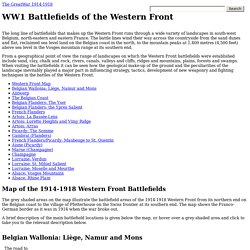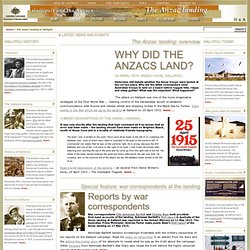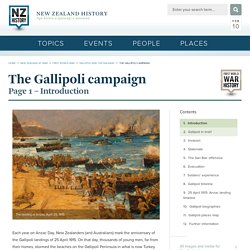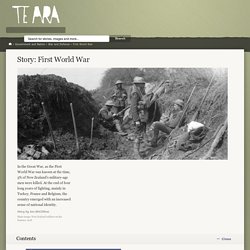

Voices Against War · Voices Against War. Online Cenotaph - Auckland War Memorial Museum. Gallipoli: The New Zealand Story. Archives New Zealand. WW1 Battlefields of the Western Front. The long line of battlefields that makes up the Western Front runs through a wide variety of landscapes in south-west Belgium, north-eastern and eastern France.

Timeline and graphic display of Allied deaths during and following WWI. BBC iWonder - How did so many soldiers survive the trenches? In the trenches of 1914-1918. Gallipoli: The New Zealand Story. The Anzac landing at Gallipoli. The Anzac landing: overview Why did theAnzacs land?

25 April 1915: Anzac Cove, Gallipoli Historians still debate whether the Anzac troops were landed at the correct place. Why did the Allied commanders send Australian troops to land on a beach before rugged hills, ridges and steep gullies? What was the objective? Auckland War Memorial Museum - Cenotaph. The Gallipoli campaign - The Gallipoli campaign. Each year on Anzac Day, New Zealanders (and Australians) mark the anniversary of the Gallipoli landings of 25 April 1915.

On that day, thousands of young men, far from their homes, stormed the beaches on the Gallipoli Peninsula in what is now Turkey. For eight long months, New Zealand troops, alongside those from Australia, Great Britain and Ireland, France, India, and Newfoundland battled harsh conditions and Ottoman forces desperately fighting to protect their homeland. By the time the campaign ended, more than 130,000 men had died: at least 87,000 Ottoman soldiers and 44,000 Allied soldiers, including more than 8700 Australians.
Among the dead were 2779 New Zealanders, about a fifth of all those who had landed on the peninsula. BBC Schools - Life in the trenches. 31 October 2014Last updated at 15:07 Two British soldiers standing in a flooded communication trench during World War One On the Western Front, the war was fought in trenches. Trenches were long, narrow ditches dug into the ground where soldiers lived all day and night. There were many lines of German trenches on one side and many lines of Allied trenches on the other. In the middle, was no man's land, so-called because it did not belong to either army.
Rest Soldiers in the trenches did not get much sleep. Dirty trenches. World War I - Battles, Facts, Videos & Pictures - History.com. Traditions and Rituals - Anzac Day Guide. The Anzac Day ceremony is rich in tradition and ritual.

It is, essentially, a military funeral, with all the solemnity and symbolism such an event entails: uniformed service personnel standing motionless around a memorial, with heads bowed and weapons reversed; a bier of wreaths laid by the mourners; the chaplain reading the words from the military burial service; the firing of three volleys; and the playing of the Last Post, followed by a prayer, hymn, and benediction. The secular ceremony Many Anzac Day ceremonies occur at war memorials. There are nearly 500 civic First World War memorials in New Zealand, most of which were erected in the 1920s. Until that time, the ceremonies took place in public buildings or churches, and sometimes had a strong religious focus. War memorials often symbolise remembrance, service and sacrifice. RSA leaders, service personnel, and local politicians increasingly took key roles, rather than the clergy.
Poppies Anzac Biscuits. Anzac Day - Anzac Day. Anzac Day occurs on 25 April.

It commemorates all New Zealanders killed in war and also honours returned servicemen and women. Papers Past. Marlborough Express — 28 December 1915 — Page 3. First World War.com - A Multimedia History of World War One. The Gallipoli Association. WW100 New Zealand. First World War. Origins The First World War was caused by the destabilisation of the balance of power in Europe due to the rise of Germany.

The war began in 1914 when Austria-Hungary invaded Serbia because of the assassination of an archduke. Countries had made alliances with each other, and soon most of Europe was at war. WORLD WAR ONE TRENCH WARFARE. Soldier & letter from home. UK sniper (?) in WWI trench.